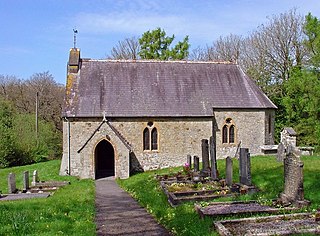
Future Systems was a London-based architectural and design practice, formerly headed by Directors Jan Kaplický and Amanda Levete.

Robert Graham Marshall-Andrews QC is a British barrister, author, and retired politician, who was the Labour Member of Parliament (MP) for Medway from 1997 to 2010. He defected from his former party at the 2017 general election and endorsed the Liberal Democrats.

Caldey Lighthouse is located on the south end of Caldey Island, three miles (5 km) off the south Pembrokeshire, Wales coastline, a small island inhabited by a Cistercian monastery.

Jan Kaplický was a Neofuturistic Czech architect who spent a significant part of his life in the United Kingdom. He was the leading architect behind the innovative design office, Future Systems. He was best known for the neofuturistic Selfridges Building in Birmingham, England, and the Media Centre at Lord's Cricket Ground in London.

Walton East is a small rural village and parish established around a church at least as early as Norman times. It is 2 miles (3.2 km) southwest of Llys y Fran and 1+1⁄2 miles (2.4 km) north of Clarbeston Road and in Wiston community in Pembrokeshire, Wales.
Edwin Dolby was an English Victorian architect who practised in Abingdon. His works include the design of Abingdon School.
Ivan Margolius is an author, architect and propagator of Czech culture and technology.

Llanddewi Velfrey or Llandewi Velfrey is a village, parish and community of Pembrokeshire in West Wales. Historically it was in the Narberth Hundred. The village is in Lampeter Vale, 2 miles (3 km) northeast of Narbeth along the A40. In 1831 it had a population of 710 people. In 2011 the population was 393.

Cnapan, also known variously as Cnapan Country House or Cnapan Restaurant and Bed & Breakfast, is a Grade II listed hotel and restaurant in Newport, Pembrokeshire. It lies along the main road of the town, East Street, which is part of the A487 road, opposite The Golden Lion.

Welsh tower houses were fortified stone houses that were built between the early 14th and 15th centuries. They are related to tower houses, which occur in considerable numbers in Ireland and Scotland and to a much lesser extent in England. A map showing the distribution of tower houses within the United Kingdom is given in Houses of the Welsh Countryside.

Plasau Duon or Plasauduon is a timber-framed house, formerly in the parish of Carno, but now within the area of the community council of Caersws in the historic county of Montgomeryshire, and now in Powys, Wales. It is located on a site above the left bank of the Afon Carno, on a farm road leading off the lane from the A.470 to Bwlch-y-garreg. It is a fine example of a ‘’Severn Valley’’ house and has a Grade II* listing. It is likely to have been built in the second half of the 16th. century.

Architecture of Wales is an overview of architecture in Wales from the medieval period to the present day, excluding castles and fortifications, ecclesiastical architecture and industrial architecture. It covers the history of domestic, commercial, and administrative architecture.

Melin Tregwynt is a woollen mill in the hamlet of Tregwynt in the parish of Granston, Pembrokeshire, Wales. A mill has stood on this site since 1819 taking fleeces from the sheep farms of the area, carding and spinning them into woollen yarn and then weaving the yarn into cloth and blankets. Today, the mill makes a line of upmarket blankets, cushions, clothing, and accessories.

Porth-y-Tŵr is a gatehouse and bell tower overlooking St Davids Cathedral in the small city of St Davids, Pembrokeshire, Wales, UK. It is the sole survivor of four medieval gates to the walled Cathedral Close. The 13th-century octagonal tower, adjoining the gateway, now contains the cathedral's bells.

Monkton Old Hall is a Grade I listed building in Pembroke, Pembrokeshire. While the chimney is of Norman architecture, the rest of the building dates from the 14th century with restorations in the late 19th and early 20th centuries.

William Owen was a Welsh architect working in Haverfordwest in the late Georgian and early Victorian periods. He built up a considerable practice in Pembrokeshire and Carmathenshire. He was the county surveyor of Pembrokeshire, four times Mayor of Haverfordwest and High Sheriff of Pembrokeshire in 1859.

The Church of St Dogfael, Meline, Pembrokeshire, Wales is a redundant church dating from the 19th century. A Grade II listed building, the church is now in the care of the Friends of Friendless Churches.
Druidston is a hamlet within the community of Nolton and Roch on the St Brides Bay coast of Pembrokeshire, Wales. Druidston Cross is an eastern outlier of the hamlet. The coast is 1/2 mile to the west where cliffs up to 80m in height overlook a rocky shore platform and the sandy beach of Druidston Haven which is popular with swimmers and surfers. The Pembrokeshire Coast Path which has since 2012 formed a part of the longer Wales Coast Path passes north - south along the cliff tops. Malator is an innovative earth house which is built into the hillside overlooking the bay.

Tafarn Sinc is a pub located in Rosebush, Pembrokeshire, Wales.

Narberth Town Hall is a municipal building in the High Street, Narberth, Pembrokeshire, Wales. The structure, which is currently used as a shop, is a Grade II listed building.



















